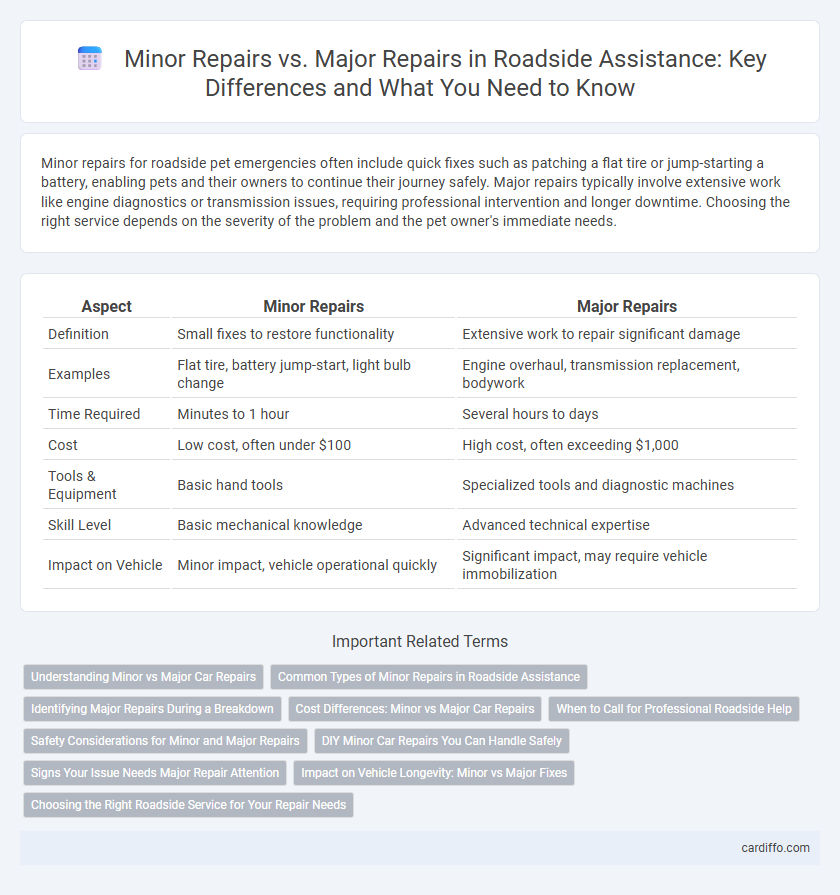Minor repairs for roadside pet emergencies often include quick fixes such as patching a flat tire or jump-starting a battery, enabling pets and their owners to continue their journey safely. Major repairs typically involve extensive work like engine diagnostics or transmission issues, requiring professional intervention and longer downtime. Choosing the right service depends on the severity of the problem and the pet owner's immediate needs.
Table of Comparison
| Aspect | Minor Repairs | Major Repairs |
|---|---|---|
| Definition | Small fixes to restore functionality | Extensive work to repair significant damage |
| Examples | Flat tire, battery jump-start, light bulb change | Engine overhaul, transmission replacement, bodywork |
| Time Required | Minutes to 1 hour | Several hours to days |
| Cost | Low cost, often under $100 | High cost, often exceeding $1,000 |
| Tools & Equipment | Basic hand tools | Specialized tools and diagnostic machines |
| Skill Level | Basic mechanical knowledge | Advanced technical expertise |
| Impact on Vehicle | Minor impact, vehicle operational quickly | Significant impact, may require vehicle immobilization |
Understanding Minor vs Major Car Repairs
Minor repairs typically involve inexpensive fixes such as replacing brake pads, changing oil, or repairing a flat tire, which help maintain vehicle safety and performance. Major repairs often include engine overhauls, transmission replacements, or extensive electrical system work, requiring more time, expertise, and higher costs. Understanding the difference between minor and major car repairs allows vehicle owners to prioritize maintenance, avoid costly breakdowns, and improve roadside assistance effectiveness.
Common Types of Minor Repairs in Roadside Assistance
Common types of minor repairs in roadside assistance include tire changes, battery jump-starts, and fuel delivery. These quick fixes often prevent further vehicle damage and minimize downtime. Addressing minor issues promptly maintains vehicle safety and ensures smooth travel.
Identifying Major Repairs During a Breakdown
Identifying major repairs during a roadside breakdown involves assessing significant damage to critical vehicle components such as the engine, transmission, or suspension system, which typically require extensive tools and expertise to fix. Unlike minor repairs like changing a flat tire or replacing a battery, major repairs often necessitate towing the vehicle to a specialized mechanic or service center. Recognizing symptoms such as severe engine noise, fluid leaks, or loss of power can help distinguish major repair needs from simpler roadside fixes.
Cost Differences: Minor vs Major Car Repairs
Minor car repairs typically cost between $50 and $300, addressing issues like brake pad replacement or oil changes, whereas major repairs can range from $1,000 to over $5,000, involving engine overhauls or transmission replacements. The significant cost difference is due to the complexity, parts, and labor time required for major repairs compared to simpler fixes in minor repairs. Choosing timely minor repairs helps prevent costly major repairs, saving both money and avoiding extended vehicle downtime.
When to Call for Professional Roadside Help
Minor repairs such as changing a flat tire or jump-starting a battery can often be handled safely by most drivers using basic roadside tools. When issues involve critical components like transmission failure, engine overheating, or brake system malfunctions, professional roadside assistance should be contacted immediately to prevent further vehicle damage and ensure safety. Recognizing symptoms such as persistent warning lights, unusual noises, or loss of vehicle control indicates the need for expert intervention.
Safety Considerations for Minor and Major Repairs
Safety considerations for minor repairs on the roadside include securing the vehicle, using warning triangles, and wearing high-visibility clothing to prevent accidents. Major repairs require professional intervention, proper tools, and stable conditions to avoid injury and further damage, often necessitating roadside assistance or towing services. Both types emphasize hazard awareness, ensuring the safety of the vehicle occupants and passing traffic.
DIY Minor Car Repairs You Can Handle Safely
DIY minor car repairs such as replacing windshield wipers, changing air filters, or fixing a flat tire can be handled safely by most vehicle owners with basic tools and instructions. These tasks prevent small issues from escalating into expensive major repairs that require professional intervention. Properly assessing the repair's scope and ensuring safety precautions help avoid roadside hazards and maintain vehicle reliability.
Signs Your Issue Needs Major Repair Attention
Visible fluid leaks, persistent engine warning lights, and unusual noises such as grinding or knocking typically indicate that roadside issues require major repair attention. Difficulty steering, significant brake problems, or repeated overheating are clear signs that minor repairs will not suffice and professional intervention is necessary. Ignoring these symptoms can lead to costly and dangerous breakdowns on the road.
Impact on Vehicle Longevity: Minor vs Major Fixes
Minor repairs, such as timely oil changes, brake pad replacements, and tire rotations, significantly enhance vehicle longevity by preventing wear and tear from escalating into severe damage. Major repairs, including engine overhauls or transmission replacements, often indicate prolonged neglect and typically reduce the vehicle's overall lifespan despite restoring functionality. Regular minor fixes maintain optimal performance and minimize the risk of costly breakdowns, directly contributing to extended vehicle durability on the road.
Choosing the Right Roadside Service for Your Repair Needs
Minor repairs such as tire punctures, battery jumps, and fuel refills require quick roadside assistance that prioritizes speed and convenience. Major repairs including engine troubles, transmission issues, or brake system failures demand specialized technicians and possibly towing services to ensure proper diagnosis and safety. Selecting the right roadside service depends on assessing the severity of the problem, the availability of certified mechanics, and the service provider's capability to handle complex repairs efficiently.
Minor Repairs vs Major Repairs Infographic

 cardiffo.com
cardiffo.com